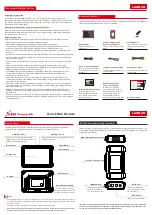
Page 5 of 26
7/9/19
SETUP / OPERATION
SET UP - Be sure the roller mill is mounted on a firm
base with adequate room for proper servicing. The roller
mill should be level while operating to allow the grain to
flow evenly across the rolls. An even flow of grain will
produce a more consistent product and helps to eliminate
unnecessary strain on roll bearings and shafts. Electric
powered units should be operated at about 780 RPM
(drive roll). Use a pulley ratio of 2.3 to 1 on 1800 RPM
motors.
CAUTION: Before attempting to operate this roller
mill, review and comply with all Safety Precautions listed
in the SAFETY portion of this manual.
CAUTION: Always check to make sure everyone is
clear of the roller mill before engaging power.
STARTING MILL - Your roller mill will not start properly
if grain is present between the rolls. Always start the
roller mill with the hopper gate in the hopper completely
closed. (See Figure 2) After bringing the rolls up to full
operating speed (780 RPM), open the hopper gate to
allow grain to the rolls. If grain is released to the rolls
before they are turning, it may bridge up and cause the
mill to stop. If this happens, shut the hopper gate, shut
down the roller mill and spread apart the rolls to allow
the excess grain to pass through before restarting the
mill. (See safety shut down procedure (Page 2) and roll
adjustment (Below).
YOUR ROLLER MILL IS DESIGNED TO ELIMINATE
COMPLICATED ADJUSTMENTS. Only two major points
of adjustment exist for any small grain or shelled corn.
HOPPER GATE CONTROL and ROLL SPACING.
HOPPER GATE CONTROL - Open the hopper gate
gradually until you reach the maximum flow of grain
that power will handle. If it becomes necessary to stop
the machine at any time before the hopper is empty, be
sure to close the hopper gate before disengaging power.
DON’T OVERCROWD ROLLS. Keep a ribbon of grain
feeding between the rolls and you’ll do a more consistent
job of rolling. This is especially true of oats and barley. It is
not necessary to completely flatten the kernel of any grain
being rolled. Grain is easier to digest when the hard coat
or hull is broken open or cracked, exposing their nutrients
to the digestive juices of livestock.
ROLL SPACING depend upon the type of grain to be
rolled and roll corrugation. Grain varies in size, shape,
toughness and moisture content. This is also true of the
same type of grain from different localities. For these
reasons, it is impossible to say exactly where to set the
rolls. The roll spacing is factory set at approximately
0.015”, placing the rolls as close together as possible. Do
not over-roll hard or dry grains, as this will cause dusting.
Remember, proper adjustment keeps dust at a minimum,
even when rolling the driest grain.
ADJUSTING ROLLS - (See Figure 3) When the roll adjust
handle is straight up, the rolls are at their closest setting,
producing the finest, or smallest, particle size possible
with the current roll corrugation. To increase the roll
spacing and particle size, loosen the locking handle on
the motor side of the mill (See Figure 1) and rotate the roll
adjust handle clockwise. A wider roll spacing is achieved
with the roll adjust handle in the horizontal position. The
curved decal by the indicator pointer of the roll adjust
handle should be used by the operator as a reference
to note frequently used roll spacing for different rolling
applications. It is not intended for specific roll spacings.
IMPORTANT: Remember to tighten the locking handle
before resuming any rolling operations.
IMPORTANT: NEVER OPERATE THE MILL WITH THE
ROLLS TOUCHING!
Figure 2
HOPPER GATE CONTROL
MAXIMUM OPENING
HOPPER
HOPPER GATE CLOSED
LOCKING
KNOB
ROLL SPACING
ADJUSTMENT
ROLL SPACING
APPROX. 0.015”
(FACTORY SETTING)
HOPPER
BASIC
ROLL SPACING
APPROX. 1/4”
(MAX. OPENING IS 1/2”
WITH HANDLE
STRAIGHT DOWN)






































